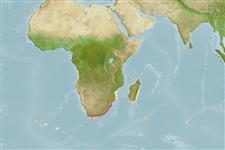>
Eupercaria/misc (Various families in series Eupercaria) >
Sparidae (Porgies)
Etymology: Rhabdosargus: Greek, rhabdos = stick + Latin, sargus = sargus (1591) (Ref. 45335).
Eponymy: Dr Emil Holub (1847–1902) was a Bohemian (Czech) naturalist who also studied South African fossils. [...] (Ref. 128868), visit book page.
More on author: Steindachner.
Environment: milieu / climate zone / Tiefenbereich / distribution range
Ökologie
seewasser; brackwasser demersal; ozeanodrom (Ref. 51243). Subtropical
Southeast Atlantic: South Africa, from the Cape to Natal.
Length at first maturity / Size / Gewicht / Alter
Geschlechtsreife: Lm 19.0 range ? - ? cm
Max length : 40.0 cm TL Männchen/unbestimmt; (Ref. 3507); common length : 15.0 cm TL Männchen/unbestimmt; (Ref. 3198)
Kurzbeschreibung
Bestimmungsschlüssel | Morphologie | Morphometrie
Rückenflossenstacheln (insgesamt) : 11; Rückenflossenweichstrahlen (insgesamt) : 12 - 13; Afterflossenstacheln: 3; Afterflossenweichstrahlen: 10 - 11. Silvery with golden midlateral band from head to caudal peduncle (Ref. 3198).
Body shape (shape guide): fusiform / normal.
Inhabits estuaries and shallow waters over sand and between rocks. Feeds mainly on small bivalves, shrimps and crabs (Ref. 3670). Flesh excellent (Ref. 3198).
Life cycle and mating behavior
Geschlechtsreife | Fortpflanzung | Ablaichen | Eier | Fecundity | Larven
Smith, J.L.B. and M.M. Smith, 1986. Sparidae. p. 580-594. In M.M. Smith and P.C. Heemstra (eds.) Smiths' sea fishes. Springer-Verlag, Berlin. (Ref. 3198)
IUCN Rote Liste Status (Ref. 130435: Version 2025-1)
Bedrohung für Menschen
Harmless
Nutzung durch Menschen
Fischereien: weniger kommerziell; Sportfisch: ja; Köder: usually
Tools
Zusatzinformationen
Download XML
Internet Quellen
Estimates based on models
Preferred temperature (Ref.
123201): 17.5 - 27.6, mean 25.6 °C (based on 237 cells).
Phylogenetic diversity index (Ref.
82804): PD
50 = 0.5156 [Uniqueness, from 0.5 = low to 2.0 = high].
Bayesian length-weight: a=0.01738 (0.01072 - 0.02817), b=3.06 (2.92 - 3.20), in cm total length, based on LWR estimates for this species & (Sub)family-body (Ref.
93245).
Trophic level (Ref.
69278): 2.8 ±0.2 se; based on diet studies.
Widerstandsfähigkeit (Ref.
120179): mittel, Verdopplung der Population dauert 1,4 - 4,4 Jahre. (Preliminary K or Fecundity.).
Fishing Vulnerability (Ref.
59153): Low to moderate vulnerability (30 of 100).
🛈
Nutrients (Ref.
124155): Calcium = 91.6 [48.0, 177.6] mg/100g; Iron = 1.13 [0.65, 2.08] mg/100g; Protein = 19.5 [18.6, 20.5] %; Omega3 = 0.379 [0.257, 0.596] g/100g; Selenium = 23.5 [11.8, 42.1] μg/100g; VitaminA = 11.6 [3.9, 29.5] μg/100g; Zinc = 1.07 [0.75, 1.50] mg/100g (wet weight);
